| SUBSIM Review |
 THE HISTORY OF SUBSIMS THE HISTORY OF SUBSIMSby Brian H. Danielson and Neal Stevens |

 Submarine
simulations were present before the beginning of the personal computer. The
first "electronic subsim" may have been "Seawolf", "Sea
Devil", or
"Submarine", one of those arcade games found in
many bowling alleys and truck stops. Similar in size to a pinball machine, this
subsim consisted of a periscope and handles. As you peered through the scope at the twilight horizon, ship silhouettes would slowly cross. You timed them and pressed the torpedo launch button on the right handle with your thumb. A small red light would streak forward and intercept the ship, lighting up the sky and emitting explosive sounds. You could play as long as your father's patience and supply of nickels didn't run out.
Submarine
simulations were present before the beginning of the personal computer. The
first "electronic subsim" may have been "Seawolf", "Sea
Devil", or
"Submarine", one of those arcade games found in
many bowling alleys and truck stops. Similar in size to a pinball machine, this
subsim consisted of a periscope and handles. As you peered through the scope at the twilight horizon, ship silhouettes would slowly cross. You timed them and pressed the torpedo launch button on the right handle with your thumb. A small red light would streak forward and intercept the ship, lighting up the sky and emitting explosive sounds. You could play as long as your father's patience and supply of nickels didn't run out.
Today, nearly twenty years later, submarine simulations have grown in scope and realism. The graphics allow you to suspend reality with ease and feel the tension and excitement our heroes lived. Instead of timing a torpedo run by eye, today's subsim
 skipper has an array of screens, equipment, and options at hand. In some cases, the complexity of the best subsims rivals reality.
skipper has an array of screens, equipment, and options at hand. In some cases, the complexity of the best subsims rivals reality.
Here we examine the pioneer programs of subsim history. By current standards, many of these subsims are antiques. But all things must have their genesis and these early efforts gave rise to a growing niche of computer games. One should consider; without GATO and Sub Battle, we might never have enjoyed Aces of the Deep and Silent Hunter.
| GATO |
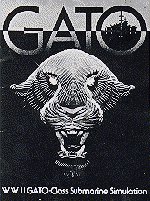 This was the
first sub simulator for a personal computer. The graphics were very limited, CGA
with stick figures for ships, of which there were five enemy types. Although it
simulated Gato class subs, there were only four bow torpedo tubes available. All
functions were generated by the keyboard (mouse? what's a mouse?). The mission
area was very limited--a group of islands in the Pacific, which was subdivided into
20 "quadrants". You pressed the "M" key for new missions and they were transmitted
by Morse code. You were instructed to keep in mind "the enemy may break Allied code at
some point. Some messages may be enemy fakes designed to trap you." How's that
for early efforts at realism? Resource management was one of the game's subtler
features. Your primary strategic objective was to complete as many missions as
possible with the supplies you carry before returning to the quadrant where your
subtender waits.
This was the
first sub simulator for a personal computer. The graphics were very limited, CGA
with stick figures for ships, of which there were five enemy types. Although it
simulated Gato class subs, there were only four bow torpedo tubes available. All
functions were generated by the keyboard (mouse? what's a mouse?). The mission
area was very limited--a group of islands in the Pacific, which was subdivided into
20 "quadrants". You pressed the "M" key for new missions and they were transmitted
by Morse code. You were instructed to keep in mind "the enemy may break Allied code at
some point. Some messages may be enemy fakes designed to trap you." How's that
for early efforts at realism? Resource management was one of the game's subtler
features. Your primary strategic objective was to complete as many missions as
possible with the supplies you carry before returning to the quadrant where your
subtender waits.

|
| Publisher | Circa | Requirements |
| Spectrum Holobyte | 1983 | 4.77 MHz, CGA, 128K RAM, 5.25" disk |
| SILENT SERVICE |
Back in its day, this was considered the standard by many. It was available on several type of PCs and game stations. It first supported CGA and then was updated to be used on EGA, but the graphics were still at CGA resolution. Even so, the visuals were a big improvement over the earlier Gato. Silent Service allowed the player to visually determine the angle on the bow of the target and factor it into the solution. The destroyer search algorithm was the best of the first generation subsims. The player commands American subs in a hunt for the Imperial Japanese Navy. This sim was revamped later and released as Silent Service II.
| Publisher | Circa | Requirements |
| Microprose | 1985 | IBM PC, 128K RAM, CGA, 5.25" disk |
| SUB BATTLE |
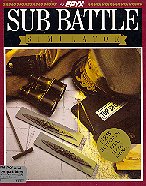 This subsim from Epyx was one of the early superstars. It first supported CGA and Hercules graphics, and was later updated for EGA (and really used EGA). Enemy ships were all black in color but had good and clearly recognizable forms. The user interface was executed beautifully. Control and status information was provided on one screen. A window within the screen features specific views such as radar, sonar, periscope, etc. It had four difficulty levels. In level four, one could see the rolling sea from the periscope.
This subsim from Epyx was one of the early superstars. It first supported CGA and Hercules graphics, and was later updated for EGA (and really used EGA). Enemy ships were all black in color but had good and clearly recognizable forms. The user interface was executed beautifully. Control and status information was provided on one screen. A window within the screen features specific views such as radar, sonar, periscope, etc. It had four difficulty levels. In level four, one could see the rolling sea from the periscope.
The programmers get an A+ for overall scope. Sub Battle supported single missions or entire WWII campaigns in the Pacific or Atlantic. For the German side, Type II, Type VIIC, and Type XXI U-boats were available. For the US, your choice is between S-class, Gato class, and Tench class, with the mission determining the actual type used. All subs had reasonably correct specifications.
 Sub Battle had an impressive list of features. The year the mission takes place determines the level of equipment available. Aircraft are present. If the sub is near the shore or a carrier, occasional patrol aircraft could cause a bad day at sea. Ships in an attacked convoy will change speeds and courses in an attempt to escape destruction. Damage a ship and its speed diminishes. Radio is used to give reports and orders, including downed pilot locations for pickup. Missions also include shore parties and minelaying. Many types of surface ships are featured, including battleships and carriers. This subsim sent so far as to include the sun and moon, even with changing phases.
A rough spot to note: The time "slow down" didn't work properly. After slowing down from accelerated time, a detected convoy might be too far out of range to plan an attack, whereas if you had been running in real time, you could have easily made the attack. But overall, Sub Battle shined.
Sub Battle had an impressive list of features. The year the mission takes place determines the level of equipment available. Aircraft are present. If the sub is near the shore or a carrier, occasional patrol aircraft could cause a bad day at sea. Ships in an attacked convoy will change speeds and courses in an attempt to escape destruction. Damage a ship and its speed diminishes. Radio is used to give reports and orders, including downed pilot locations for pickup. Missions also include shore parties and minelaying. Many types of surface ships are featured, including battleships and carriers. This subsim sent so far as to include the sun and moon, even with changing phases.
A rough spot to note: The time "slow down" didn't work properly. After slowing down from accelerated time, a detected convoy might be too far out of range to plan an attack, whereas if you had been running in real time, you could have easily made the attack. But overall, Sub Battle shined.
Note of interest: Game designer Mike Jones, who later went on to craft Aces of the Deep, worked on this game.
| Publisher | Circa | Requirements |
| Epyx | 1986 | IBM PC, EGA, 512K RAM, 5.25" disk |
| UP PERISCOPE! |
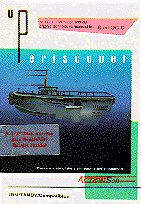 Another WWII subsim from the American perspective, Up Periscope! supported single missions or patrols. Several historic scenarios were also available as well as the option of general patrols.
Another WWII subsim from the American perspective, Up Periscope! supported single missions or patrols. Several historic scenarios were also available as well as the option of general patrols.
Up Periscope! originated a few new ideas, but they were not implemented well. First, the concept of variable visibility (possibly due to fog) for daytime was introduced. Second, the user had to make several periscope, radar, or sonar contacts at different times to generate an accurate shooting solution. A minimum of two marks was required to fire using the TCD in manual. This added to the realism and difficulty but the drawback was once you fired at a specific ship in a convoy, you couldn't transfer the settings to the next ship for a second shot. By the time you developed another solution the convoy would slip out of position or the destroyers would be all over you.
Torpedo implementation had some interesting characteristics. Torpedo gyro angles were a factor. The closer you pointed your bow to the projected track, the greater your chances of scoring a hit (this wasn't implemented in any other subsims to this time). Strangely, to fire the aft torpedoes at a target, you needed to point the bow toward the target.
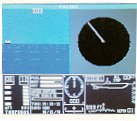 Graphics weren't bad, considering it was CGA resolution. Ships were rendered in white and black with black masts. Aircraft weren't included but the skill level of the enemy ships could be adjusted, affecting their evasive zigzagging, aggressiveness, and DC accuracy. Up Periscope also included a 120 page booklet title "Submarine Action in the South Pacific". Filled with facts, illustrations, and historical data, this booklet doubled the value of the sim.
Graphics weren't bad, considering it was CGA resolution. Ships were rendered in white and black with black masts. Aircraft weren't included but the skill level of the enemy ships could be adjusted, affecting their evasive zigzagging, aggressiveness, and DC accuracy. Up Periscope also included a 120 page booklet title "Submarine Action in the South Pacific". Filled with facts, illustrations, and historical data, this booklet doubled the value of the sim.
| Publisher | Circa | Requirements |
| Actionsoft | 1986 | IBM PC, CGA, 256K RAM, 5.25" disk |
| CODENAME: ICEMAN |
 Sierra pioneered the graphic adventure game with King's Quest in the early eighties. Codename: ICEMAN is a graphic adventure game that includes some submarine play. Not a true subsim, ICEMAN entertains nonetheless.
Sierra pioneered the graphic adventure game with King's Quest in the early eighties. Codename: ICEMAN is a graphic adventure game that includes some submarine play. Not a true subsim, ICEMAN entertains nonetheless.
The nature of a graphic adventure game means the player must explore the environment, "looking", "talking", and "getting" every object and person his character comes across. You can't leave the island unless you discover and use all the items hidden in the setting. Johnny Westland, the game character, is a Navy commander on leave in Tahiti. You begin the game with Johnny lolling on the beach. During the Tahiti episode, you will play volleyball, administer CPR to a drowning victim, dance with and romance a clubgirl, and eventually receive news you must return to active duty. You do all these things by directing Johnny with the arrow keys and endlessly typing in "LOOK AT WALL", GET EARRING", or "SIT DOWN". I nearly went bonkers trying to use the phone to get a transport to the airport--the other party didn't like what I said and kept hanging up. Until I found the exact words, I was stuck in the bungalow bedroom, redialing, redialing, redialing....
 Patience is a big necessity with ICEMAN. Once in the futurist sub, the captain directs you. If you fail to respond correctly or promptly, game over. Don't forget to save often. The aim of all this adventuring is to locate and rescue an ambassador being held by terrorists. The submarine part of this game isn't very realistic, but a player can enjoy the "action" if he doesn't mind lots of typing.
Patience is a big necessity with ICEMAN. Once in the futurist sub, the captain directs you. If you fail to respond correctly or promptly, game over. Don't forget to save often. The aim of all this adventuring is to locate and rescue an ambassador being held by terrorists. The submarine part of this game isn't very realistic, but a player can enjoy the "action" if he doesn't mind lots of typing.
| Publisher | Circa | Requirements |
| Sierra | 1986 | IBM PC, 8 MHz, 512K RAM, VGA, 5.25"/3.5" disks |
| 688 ATTACK SUB |
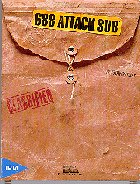 In 1988, a company named Electronic Arts presented subsim skippers with 688 Attack Sub. Designed by John Ratcliff and Paul Grace, 688 Attack Sub was the predecessor to Seawolf SSN-21 and Jane's 688(I) Hunter/Killer. Ten missions chronicle 688's part in a Cold War that grows progressively hotter. In most of these missions, you may command either a US 688 class sub, or a Soviet Alfa. The Alfa was the USSR's titanium hulled hotrod, capable of an estimated 45+ knots and ~3000 feet.
In 1988, a company named Electronic Arts presented subsim skippers with 688 Attack Sub. Designed by John Ratcliff and Paul Grace, 688 Attack Sub was the predecessor to Seawolf SSN-21 and Jane's 688(I) Hunter/Killer. Ten missions chronicle 688's part in a Cold War that grows progressively hotter. In most of these missions, you may command either a US 688 class sub, or a Soviet Alfa. The Alfa was the USSR's titanium hulled hotrod, capable of an estimated 45+ knots and ~3000 feet.
The goal of each mission was dependant on the type of sub chosen. In some missions, the 688 is requested to protect a convoy, whereas the Alfa would attempt to sink it. Other missions involved only sub vs. sub scenarios. There were many types of vessels included in the sim, but within any particular mission, the same set of vessels was used. There were a limited number of initial setups for a mission, so the action, while not entirely random, had some variability.
 Performance was best on a 286 or faster PC. EGA graphics gave good results, with VGA preferred. A mouse greatly benefited the interface use. There are several screens that one must flip through (i.e. from the navigation console to the weapons room) and this presents some difficulty in executing commands quickly (defined function keys helped solve this problem).
Performance was best on a 286 or faster PC. EGA graphics gave good results, with VGA preferred. A mouse greatly benefited the interface use. There are several screens that one must flip through (i.e. from the navigation console to the weapons room) and this presents some difficulty in executing commands quickly (defined function keys helped solve this problem).
Several other features worth noting. Multiple thermal layers are provided on most missions giving hiding places if used correctly. The implementation of these layers is very well done, making the act of hiding from enemy ships and submarines a real art. Wire guided torpedoes are used. The passive sonar has a signature processor that allows the player to determine ship/sub types by both sound and graph. A retractable sonar array is provided.
 688 Attack Sub has one very special feature. It allows two players, on different PCs, to play each other via a modem (or null-modem cable). Typically, one player chooses to be the Alfa, while the other player is the 688 sub. Such games tend to be incredibly intense since players do not always behave in a predictable manner. 688 Attack Sub, therefore, heralded one of the most useful and important features a subsim can possess; the ability for friends to pit their acumen against each other.
688 Attack Sub has one very special feature. It allows two players, on different PCs, to play each other via a modem (or null-modem cable). Typically, one player chooses to be the Alfa, while the other player is the 688 sub. Such games tend to be incredibly intense since players do not always behave in a predictable manner. 688 Attack Sub, therefore, heralded one of the most useful and important features a subsim can possess; the ability for friends to pit their acumen against each other.
This sim also has a few problems. Foremost on the list is that explosion sounds lock up interactive commands. For example, if you are diving and near the bottom, and torpedo explosions are heard, you can't stop the dive until the sounds are over, which probably means a damaged sub as a result of hitting the bottom. Also, modem play will occasionally have strange results (i.e. player 'A' sunk while player 'B' continues tracking player 'A'). Overall, though, with the mouse interface, multiple screens, good graphics, and modem play, 688 Attack Sub can be viewed as a milestone in subsim development.
| Publisher | Circa | Requirements |
| Electronic Arts | 1988 | IBM PC/XT/AT, 384K RAM, 256 VGA, 5.25" disk |
| HUNT FOR RED OCTOBER |
Taken from Tom Clancy's career-launching novel, The Hunt For Red October attempts to follow the general plot of the book. This means that you are to head west and escape all the ships of the USSR as well as appear ready to defect to the United States. The graphics were EGA only (unless updated later). The joystick is used, but very difficult to control. The graphics and screen layouts were very poor in general. HFRO didn't enjoy any lasting success as a subsim.
| Publisher | Circa | Requirements |
| Unknown | 1988 | EGA |
| RED STORM RISING |
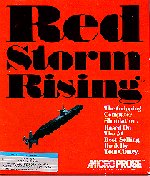 Red Storm Rising is based on the plot of the book by the same name. It ran well on 8088 turbo systems with monochrome Hercules graphics, EGA or VGA (color is recommended). A faster PC helps speed up the game slightly. A joystick can be used in conjunction with the keyboard but keyboard entry alone is very satisfactory. There are so many keyboard controls that a keyboard overlay is provided to aid in remembering the functions of the keys.
Red Storm Rising is based on the plot of the book by the same name. It ran well on 8088 turbo systems with monochrome Hercules graphics, EGA or VGA (color is recommended). A faster PC helps speed up the game slightly. A joystick can be used in conjunction with the keyboard but keyboard entry alone is very satisfactory. There are so many keyboard controls that a keyboard overlay is provided to aid in remembering the functions of the keys.
While this simulator has several single mission selections, the main challenge is the entire WWIII campaign. There were several skill levels and several levels of technology (determined by year of conflict: 1984, 1988, 1992, 1996). Several classes of subs were available, including Permit, Sturgeon, 688, improved 688, and Seawolf (for 1996 only).
There were a vast number of campaign missions and, if repeated, they were always random in location as well as types of ships involved, a truly dynamic campaign. Subsim skippers are never satisfied with "canned' missions and this contributed to the success RSR enjoyed. Some missions include only submarines, others include only a surface convoy, others include a surface task force (with carriers), and others with both ships and subs. Helicopters with sonar dipping equipment and sonar buoys add much to the turmoil.
 With the most challenging settings, events get so complex, and events occur so quickly, that having two people at the keyboard is a great help, and for beginners, almost a necessity (plus it is more fun). Trying to identify ships with signature analysis, running from incoming torpedoes, launching noise makers and decoys, dealing with several of your own wire-guided fish, and launching Harpoon and Tomahawk missiles makes for a very busy captain.
With the most challenging settings, events get so complex, and events occur so quickly, that having two people at the keyboard is a great help, and for beginners, almost a necessity (plus it is more fun). Trying to identify ships with signature analysis, running from incoming torpedoes, launching noise makers and decoys, dealing with several of your own wire-guided fish, and launching Harpoon and Tomahawk missiles makes for a very busy captain.
There are not any known bugs or problems with this simulator that mar it. Since much modern submarine technology is still classified, it's difficult to specify any technical errors but I will say that the simulation 'feels' about right (especially in the highest skill level).
Red Storm Rising demonstrates one other characteristic: it's still sought after and played by cyber skippers today, ten years after its release. The greatest legacy any subsim could hope to aspire to.
| Publisher | Circa | Requirements |
| Microprose | 1988 | IBM PC/XT/AT, 384K RAM, 16 VGA, 5.25" disk |
| DAS BOOT |
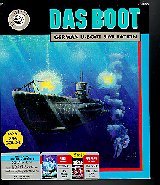 Das Boot has aircraft, enemy and friendly submarines, interactive anti-aircraft gun and deck gun firing controls, fantastic ideas for radio (including the capability to decode enemy transmissions), and more. I have never seen a program with so many great ideas come together with such disaster. This is due, in part, to the lack of scope of the simulation. For example, one of the missions is the "Das Boot" mission. It begins in the Gibraltar Strait. You are ordered east through the strait. You are quickly attacked by aircraft, and not permitted to dive. It is foggy and you can't see anything but aircraft. If you are a good shot, you can shoot down all the planes. If you do so, you win, and that is that.
Das Boot has aircraft, enemy and friendly submarines, interactive anti-aircraft gun and deck gun firing controls, fantastic ideas for radio (including the capability to decode enemy transmissions), and more. I have never seen a program with so many great ideas come together with such disaster. This is due, in part, to the lack of scope of the simulation. For example, one of the missions is the "Das Boot" mission. It begins in the Gibraltar Strait. You are ordered east through the strait. You are quickly attacked by aircraft, and not permitted to dive. It is foggy and you can't see anything but aircraft. If you are a good shot, you can shoot down all the planes. If you do so, you win, and that is that.
 This simulator is the only one that uses true three dimensional polygon filling graphics. This type of graphics is usually used with flight simulators. The advantage of this technique is that you get a real three dimensional effect. However, you are unable to show object detail. With fast jet aircraft simulators, lack of detail is fine, since you only see the enemy for a split second. But, for submarine simulators that operate at such slow speeds, lack of detail is very annoying. In Das Boot, it is impossible to determine the identification of a vessel by sight. You must have the XO "ID" the vessel to know what type it is.
This simulator is the only one that uses true three dimensional polygon filling graphics. This type of graphics is usually used with flight simulators. The advantage of this technique is that you get a real three dimensional effect. However, you are unable to show object detail. With fast jet aircraft simulators, lack of detail is fine, since you only see the enemy for a split second. But, for submarine simulators that operate at such slow speeds, lack of detail is very annoying. In Das Boot, it is impossible to determine the identification of a vessel by sight. You must have the XO "ID" the vessel to know what type it is.
Other features were the use of time compression, different external views, enemy use of HF/DF against you ("maintain radio silence to avoid detection"), Metox, and different torpedo types. With the ground-breaking graphics, Das Boot had a lot of promise, but the lack of career missions pretty much sank it.
| Publisher | Circa | Requirements |
| Three Sixty/EA | 1990 | IBM PC, DOS 2.11+, 512K RAM, 256 VGA, 5.25" disk |
Submarine simulations have come a really long way since the simple gameplay of Gato. The realism has become ever more accurate. Graphics and sounds have evolved to the point of near-animation quality, and will continue to improve. Almost all subsims here included historical information with the playing manuals, proof that the creators were really passionate about the nature of the programs. In the year 2006, as you're putting on your cyber helmet and dropping the view-visor, as the tandem 2000MHz processors wind up to speed, pause a moment before engaging the simulation and reflect on the early eighties. Stick graphics, buzzing PC speakers, and boot disks...these were the Model T subsims indeed!
| ABOUT THE AUTHOR |
| Brian Danielson works as a programmer for a major hardware company wringing out performance on D3D drivers. He's one of the most experienced subsim skippers around, getting in on the genre from the start in the early eighties. He was a contributor of information for Aces of the Deep and a programmer for Command AOD. Noted for his attention to detail, Brian has been known to keep mission logs, calculate manual firing solutions, and construct his own TDC programs. A regular contributor and technical advisor to SUBSIM Review, he continues to ply the seas in the latest subsims such as Silent Hunter and Jane's 688(I). |
Other Sub Simulators
Seawolf
by Xype
 Atari
2600 programmer Manuel Rotschkar (Gunfight, Star Fire) has completed his latest
Atari 2600 title, Seawolf, which will be his 4K entry in the 2004 MiniGame
Competition. This game is influenced and inspired by the Midway Sea Wolf and Sea
Wolf II arcade games as well as the Astrocade and 8-bit home versions, but is
not a direct port. Seawolf also borrows elements from Broderbund's Seafox. In
Seawolf you command a submarine lurking below the surface of the ocean, where
you need to attack enemy convoys while avoiding depth charges and other dangers.
But use your resources wisely, as you don't want to be a sitting duck when you
run out of torpedoes, or worse, fuel! And watch out for the Red Cross ships, as
they have a surprise for you if you accidently target them! Seawolf features
four difficulty settings, with a matching color-coded score display so you can
tell which difficulty setting you are playing at quick glance. Seawolf is the
first Atari 2600 homebrew to feature 24 pixel wide multicolor sprites.
Atari
2600 programmer Manuel Rotschkar (Gunfight, Star Fire) has completed his latest
Atari 2600 title, Seawolf, which will be his 4K entry in the 2004 MiniGame
Competition. This game is influenced and inspired by the Midway Sea Wolf and Sea
Wolf II arcade games as well as the Astrocade and 8-bit home versions, but is
not a direct port. Seawolf also borrows elements from Broderbund's Seafox. In
Seawolf you command a submarine lurking below the surface of the ocean, where
you need to attack enemy convoys while avoiding depth charges and other dangers.
But use your resources wisely, as you don't want to be a sitting duck when you
run out of torpedoes, or worse, fuel! And watch out for the Red Cross ships, as
they have a surprise for you if you accidently target them! Seawolf features
four difficulty settings, with a matching color-coded score display so you can
tell which difficulty setting you are playing at quick glance. Seawolf is the
first Atari 2600 homebrew to feature 24 pixel wide multicolor sprites.
Author: Manuel Rotschkar
Number of Players: 1
Controller: Joystick
Cartridge Size: 4K
Manual Design: Dave Exton
Return to SUBSIM Review
©1998 SUBSIM Review